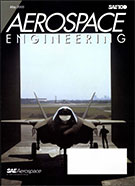Magazine

Aerospace Engineering 2006-05-01
2006-05-01
Materials mature The growth of air travel has always been dependent on the development of materials technology for structures and engines. Keeping track of production Aircraft manufacturers are making greater use of RFID and bar code technology, while also using new software that helps them keep production lines running smoothly. Breaking records via fuel management Onboard sensors reported lower-than-expectedfuel-tank readings not far into the around-the-world flight of the GlobalFlyer, jeopardizing the entire mission.



















